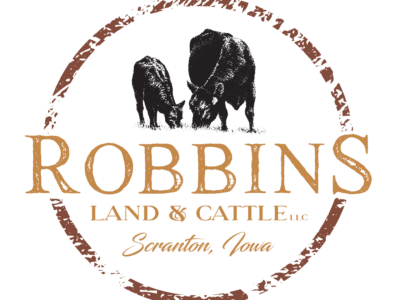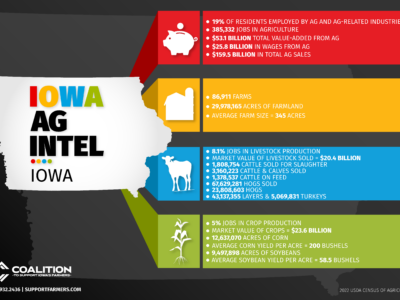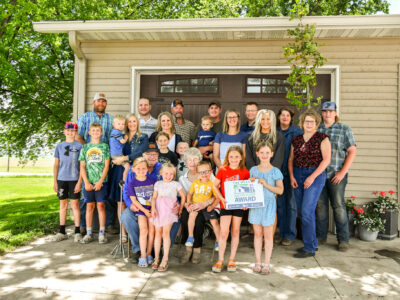Livestock Provides Opportunities for Beginning Farmers
02-02-2016 in Livestock
Beginning or expanding a farming operation takes money.
For the young farmer, finding the necessary funding can be daunting – but not impossible.
The CSIF Farming for The Future Conference, held January 21 in Ames, highlighted existing programs targeted toward the beginning farmer and offered advice on producer/lender relations with a line-up of financing expert presentations.
“You should also know your financial programs and options better or as well as your banker,” said Iowa Farm Bureau Farm Business Development Manager Amanda Van Steenwyk. “Know that information before you get there.”
Winding through those programs is the job of conference presenters Steve Ferguson, Program Specialist with the Iowa Ag Development Division of the Iowa Finance Authority, and Brian Gossling, Farm Loan Program Director for the Iowa Farm Service Agency, who delved into details of loan and tax credit options.
“The main thing to remember is your banker wants you to succeed,” added Jayme Ungs, Vice President and Division Agricultural Specialist with U.S. Bank.
Lenders, Farm Service Agency, and the Iowa Finance Authority all work together to make ag dreams happen.
“Seventy percent of beginning farmers use FSA to get started,” said Gossling. “Programs can be used to buy land or make improvements. They’re designed to provide an entry point into farming.”
For instance, a farmer can provide a 5 percent down payment, borrow 45 percent (up to $300,000) from FSA, and finance the remaining 50 percent through the IADD (Iowa Finance Authority) or another funding source.
“These programs are designed to keep payments low early in the business cycle to help the beginning farmer,” added Gossling.
FSA offers both direct and guaranteed loans, for both farm ownership and operating expenses.
“The Coalition has received a record number of inquiries from livestock farmers over the past two years – many from beginning farmers wanting to get into farming, but unsure what opportunities were available to them,” said Brian Waddingham, executive director of CSIF. “With the price of land today, livestock is still one of the best ways for a young person to get back to the farm. The Coalition is that trusted third party resource that can assist the new and beginning farmer or well-established farmer with free and confidential advice to help them achieve their goals.”
IADD offers a combination of loan programs and tax credits for both the new farmer and existing landowners. The agency defines a beginning farmer as anyone over the age of 18 with three to 10 years experience and a net worth of less than $672,171.
“These programs not only help with financing, but encourage landowners to sell or lease land, equipment or breeding livestock to beginning farmers,” explained Ferguson. “They can be a valuable marketing tool when negotiating with neighbors and setting contract terms.”
Both agencies work with traditional lending institutions, who expect the farmer to be prepared when he/she arrives at the bank.
“I rely on your knowledge and information,” said Ungs. He expects numbers – break-even point, cost of production, living expenses, profit margins, and subsidies. “I can’t assume. You have to help me make the case to the loan committee.” Every operation is unique, and Ungs stressed the most important part is to “have a plan” and the information to back it up.
Van Steenwyk, through the Farm Bureau Farm Business Development program, can help with that. She encouraged beginning farmers to assess their vision and set goals – then work them into a formalized business plan. “And know your contingencies,” said Van Steenwyk. “Show your lender you’ve thought about the worst case scenarios and have a plan to address them.”
She added it is also vital to understand the difference between cash flow and balance statements. “Know the difference. Know what is an expense and what is debt.”
That’s important to Ungs. “Cash flow is king,” he said, “and it’s the thing a young farmer lacks most. That’s how you withstand the bad times. A balance sheet can show equity, but that doesn’t pay the bills.”
Ungs said he not only expects his clients to be prepared, but also to be honest and realistic. “We’ve seen bad times before. We understand. We just don’t like surprises.”
By Terri Queck-Matzie for CSIF
Recommended News

Robbins Family Hosts Cattle Building Open House
Farmers interested in learning about the benefits of raising cattle under roof are invited to attend an open house at the Robbins family farm to tour Justin and Lacie Robbins...
Read More
NEW STUDY SHOWS IOWA AGRICULTURE EVEN STRONGER
Iowa’s 86,911 family farms continue to be a key driver of Iowa’s economy, contributing 32 percent more to the state economy than in 2017, according to a new study commissioned...
Read More
Farming is a Family Affair
The Streit family of West Bend, Iowa, has cultivated their farm for over three decades, fostering a legacy of hard work and community support. Diane and Tony Streit, alongside their...
Read More